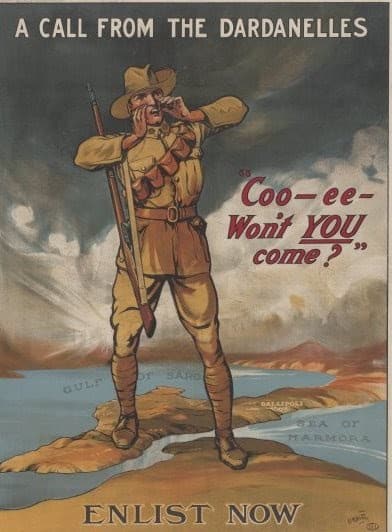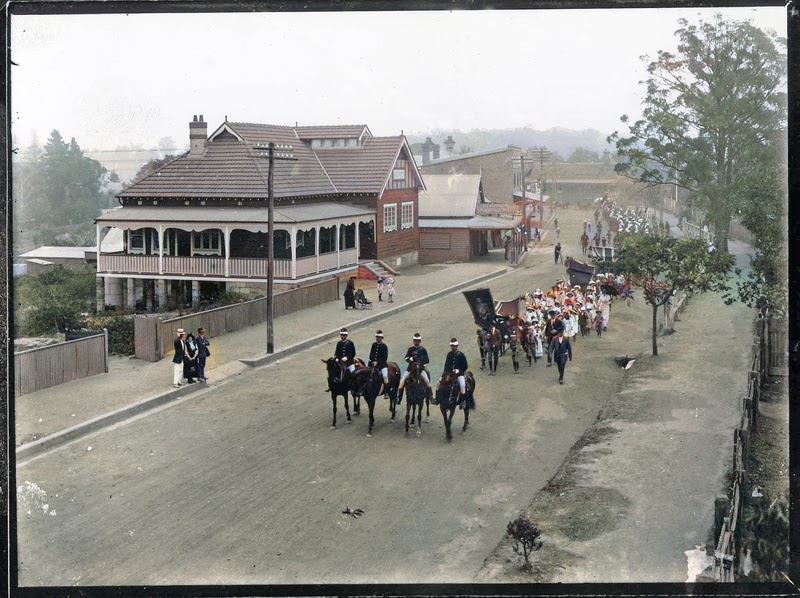The Gilgandra Snowball March AKA The Cooee March
A day stamped in the history of Springwood
It was 1915, an unseasonably warm early November spring morning. The smell of distant bushfires was evident throughout the Springwood area and a musty, smokey haze had settled in the air. William (Bill) Thomas Hitchin laced up his boots in preparation for the day. Boots that had served him well, boots that had travelled underfoot for almost a month – all the way from Gilgandra by this stage. That’s 285 miles or 459 kilometres in today’s money. Never-the-less and the smoke aside, Hitchin and his boys were determined to gather much needed man-power along their route to the state’s capital.
Today was Monday, the eighth and for just shy of a month since the 10th of October, calls of ‘cooee!’ had been echoing along quaint the towns of the Orana, right down through the Central West and now up onto the majestic Blue Mountains. The original group of 25 men, had by now swollen to a patriotic number of just over 300* and their message was clear and simple ‘join us to help our men in the Dardanelles.’
By 1915, news of the increasing casualties in France as well as the struggles of our men in Gallipoli and the Dardanelles was widespread across the nation. In turn, this had a great effect on recruitment numbers. Hearing of the terrible losses and disastrous campaigns, it was no wonder that many young men were turned off joining the cause. The Australian Government was pushing recruitment at rallies and through official government communications such as the newspapers, but it was having little effect.

The idea to march for recruitment and gather able men along the way was born out of the brotherly chat between Bill Hitchin, a plumber and his brother Dick who was the local butcher in Gilgandra. A recruitment march of this kind, later referred to as a ‘snowball march’ due to the increasing size gained along the route, was something that had not been done in this way before. The State Recruiting Board wasn’t keen to recruit men via a march. There were concerns about the safety of the boys along the route and how they would be fed, especially if the numbers grew as they did. Hitchen however, was only concerned about the men on the front overseas, the ones who were fighting for our great nation. Bill began to spread the word around town, drummed up the support of 24 other candidates and soon after, the march left Gilgandra for the big smoke.
By the time the marchers were on the approach to Springwood, they were much celebrated nationwide and greatly anticipated by the locals. All of the newspapers, from the regional presses right through to the big Sydney papers had been providing day-by-day updates of the march, as well as the celebrations and cheery receptions from each town along the way. For the arrival into Springwood Bill and the cooees were joined by the Leura band as well as a piper sent to join them by the local Highland Society. The image below, shows the men parading proudly along Macquarie Street with the railway station just visible in the background.

School children lined the streets, girls wore nurses uniforms and boys wore khaki to welcome the recruits. Banners flew proudly and Springwood turned on the celebrations and showed support well into the evening. At night, over 1,000 locals attended a music concert which was followed by passionate recruitment speeches. 5 brave local boys left with the cooees the next morning, proudly marching down the mountain arriving in Penrith late in the afternoon.
Hitchen’s Cooee March was the first of its kind in Australia and paved the way for many more that followed. Twelve more marches, nationwide, recruited many more men to help the war effort – and it wasn’t just those men who joined the physical marches as they passed – the snowball marches brought with them awareness, stirred passion and beamed to the country one of the best displays of true Aussie ‘mateship’.
From the original 25 men who left Gilgandra, 263 were recruited into the Australian Armed Forces in Sydney. Bill Hitchen gave his age as 44, however he was actually 51 at the time. BIll, in spite of his amazing efforts helping to recruit, died in an army hospital in the UK in 1916 before he ever saw active service. Most of the men who marched with Higgins saw service in the 13th and 45th Battalions.
The day of 8 November, 1915 is a proud one in the history of Springwood, NSW. A day that the entire town rallied to boost morale and support the recruitment efforts of the brave men who marched off to war to protect our Aussie way of life.
To celebrate the spirit of the Cooee’s, and the ANZACs that they became, the chefs at Gather, Springwood Sports Club, have created a special ANZAC Day menu. The menu, complete of course with ANZAC biscuits, is your chance to come in, enjoy some good grub and have a beer for the brave men and women who fought and served for our country.
Lest we forget.
*Some of the Cooee Marchers didn’t pass their medical examinations so the final number of men recruited was lower at 263.
